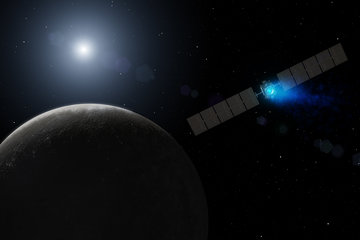Osiris has its target in sight
The scientific imaging system on board ESA’s spacecraft Rosetta gets its first glimpse of comet Churyumov-Gerasimenko

After the wake-up call on 20 January 2014 tore Rosetta from its more than 30 months of hibernation, now all technical systems and scientific instruments are gradually being awakened to life. In the past days, it was the turn of the orbiter’s scientific imaging system OSIRIS. “The instrument has apparently survived its time-out in good shape. Everything is working as expected”, says Principal Investigator Holger Sierks from the MPS.
The first images of comet 67P/Churyumov-Gerasimenko confirm this. At this point, more than five million kilometres are still separating comet and spacecraft. The comet therefore fills only a fraction of a pixel. Since, in addition, the body is still rather dim, long exposures of 60 to 300 seconds and additional steps of image processing were necessary in order to make it visible.
“Finally seeing our target after a ten year’s journey through space is an incredible feeling”, says Sierks. “These first images taken from such a huge distance show us that OSIRIS is ready for the upcoming adventure. Soon we will see the comet’s activity awakening”, he adds.
During its long journey through the solar system OSIRIS has already demonstrated its capabilities on several occasions: the instrument provided impressive images during flybys of Earth and Mars and was able to scientifically study the asteroids Steins and Lutetia.
In the coming months, OSIRIS will again allow insights into a new world: At first, the shots will help to assess the comet’s activity by its brightness; from mid-July the images will allow to assess the body’s shape.
During the mission, the camera system will visualize structures in the so-called coma, the atmosphere of the comet, and examine the topography and composition of the comet's surface. As of the summer of this year, one of the main focuses will be on the search for a suitable landing site for Rosetta’s lander Philae. Philae is scheduled to touch-down on the comet’s surface in November 2014.
###
Rosetta is an ESA mission with contributions from its member states and NASA. Rosetta will be the first mission in history to rendezvous with a comet, escort it as it orbits the Sun, and deploy a lander to its surface.
The scientific imaging system OSIRIS was built by a consortium led by the Max Planck Institute for Solar System Research (Germany) in collaboration with CISAS, University of Padova (Italy), the Laboratoire d'Astrophysique de Marseille (France), the Instituto de Astrofísica de Andalucia, CSIC (Spain), the Research and Scientific Support Department of the European Space Agency (The Netherlands), the Instituto Nacional de Técnica Aeroespacial (Spain), the Universidad Politéchnica de Madrid (Spain), the Department of Physics and Astronomy of Uppsala University (Sweden), and the Institute of Computer and Network Engineering of the TU Braunschweig (Germany).
BK / HOR












